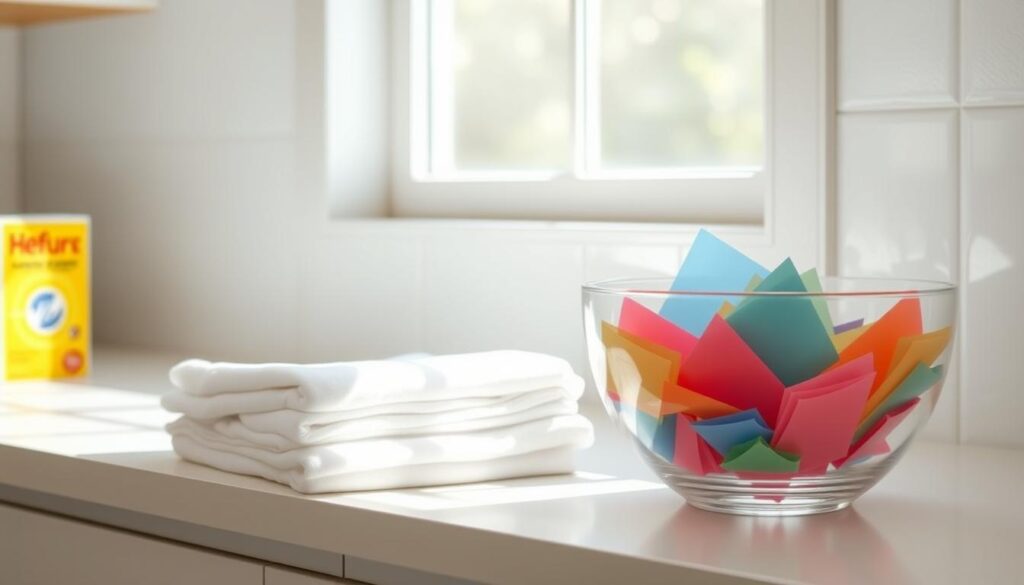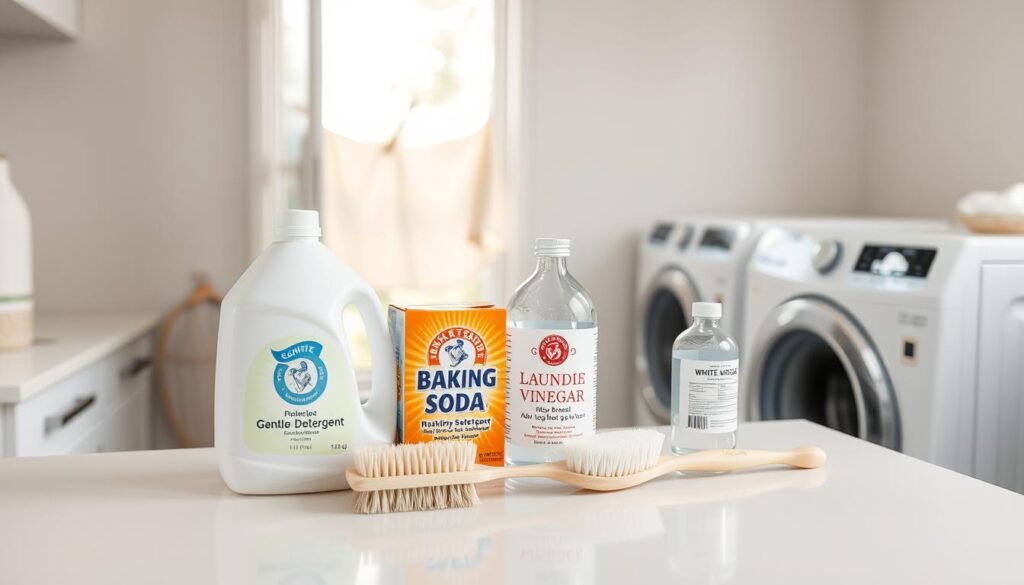Why do white clothes fade or yellow despite regular washing? This article reveals science-backed solutions to keep your whites bright and crisp. Discover why common laundry habits might be causing discoloration and how to fix them with simple adjustments.
Key Takeaways
- Yellowing often starts with residue buildup in washing machines.
- Warm water improves detergent effectiveness but risks fabric damage.
- OxiClean or similar detergents break down stains without harsh chemicals.
- Over-drying traps dirt, dulling whites over time.
- Regular cleaning of washing machine drums prevents stubborn stains.
From detergent choices to drying techniques, this guide covers every step to preserve brightness. Learn how small changes can stop yellowing before it starts.
Understanding the Causes of Yellowing
Yellow stains on white clothes often start long before laundry day. To prevent yellowing in white clothes, it’s crucial to identify the root causes. Body oils, sweat, and residue from lotions or deodorants cling to fabrics, breaking down over time and causing discoloration. These factors combine with other elements during washing to form stubborn stains.
Common Factors Leading to Yellowing
- Body oils mix with detergent residue, creating sticky films.
- Perspiration leaves salt deposits that attract dirt.
- Product residues from hair sprays or skincare products accelerate fading.
The Role of Detergents
Overusing detergent leaves a filmy residue. Underdosing fails to rinse completely. Look for enzymes in detergents like Tide with Febreze or OxiClean to break down organic stains. Woolite Free & Clear is ideal for sensitive fabrics to avoid yellow stains on white clothes.
Impact of Water Quality
Hard water leaves mineral deposits, especially iron and magnesium. These minerals bind with detergent, forming visible yellowish buildup. Areas like the Midwest U.S. face higher hard water challenges, requiring water softeners or additives like Calgon to balance minerals.
Choosing the Right Detergent
Proper detergent selection is key to maintaining bright whites. Washing white clothes properly starts with formulas designed to combat stains without dulling fabric. Here’s how to pick solutions that protect your garments while enhancing brightness.
Oxi-Cleaning Detergents: A Powerful Option
Oxygen-based cleaners break down stains using enzymes instead of harsh chemicals. Look for products like OxiClean or Gain Oxi-Bright, which use sodium percarbonate to lift dirt without residue. These work best in cold water, preserving fabric integrity.
Avoid Common Bleach Alternatives
- Ammonia or vinegar alone can weaken fibers over time
- Avoid laundry detergents with optical brighteners if you have hard water—they leave stubborn residue
- Check pH levels: Neutral pH detergents prevent yellowing from chemical imbalances
Top Brands for Bright Whites
| Brand | Key Ingredients | Why It Works |
|---|---|---|
| Tide with Bleach Alternative | Hydrogen peroxide, surfactants | Safe for colored whites and sensitive fabrics |
| Persil ProClean | Enzyme blends, oxygen boosters | Effective in both hard and soft water conditions |
| Arm & Hammer Oxi Action | Carbonate peroxide crystals | Mineral-neutral formula prevents graying |
Pair these detergents with white clothes washing tips like sorting by fabric type and avoiding overloading machines. Always check care labels for fiber-specific guidelines to maximize results.
Prepping Your Whites Before Washing
Proper preparation stops yellowing before it starts. These steps lay the foundation for laundry tips for white garments that stay bright longer:
Sorting Clothes Properly
Separate items into three groups:
- Cotton: Towels and t-shirts go together.
- Synthetic blends: Sheets and dress shirts need gentler cycles.
- Delicates: Lace or silk whites should be handwashed separately.
Mixing fabrics causes uneven wear and color transfer.
Treating Stains Before Wash
Act fast to remove stubborn stains:
- Coffee/wine: Blot excess, then soak in cold water with 1 tbsp vinegar.
- Sweat stains: Rub undiluted hydrogen peroxide on underarm areas.
- Makeup: Use a cotton ball dipped in rubbing alcohol to lift foundation residue.
The Importance of Fabric Care Labels
Labels reveal hidden care rules. A triangle with a hand icon means hand wash only. Ignore symbols like “do not bleach” and you risk damaging fabric integrity. Always check temperature limits to prevent overwashing, a common cause of yellowing.
Optimal Washing Machine Settings
Getting the most out of your washing machine starts with the right settings. expert advice for washing white items focuses on balancing cleaning power with fabric care. Proper settings ensure your whites stay bright without damage.
Cycle Types for White Clothes
Choose cycles based on fabric durability and soiling levels:
- Normal Cycle: Ideal for sturdy items like towels and bed linens.
- Heavy-Duty: Use for heavily soiled fabrics like gym clothes or tablecloths.
- Delicate Cycle: Reserved for fine fabrics like silk or lace—always check garment labels first.
Water Temperature Guidelines
Water temperature directly impacts stain removal and fabric longevity:
| Temperature | Best For | Notes |
|---|---|---|
| Hot Water | Cotton whites, grease stains | Use only if labels permit |
| Warm Water | Synthetic blends, everyday wear | Effective for most casual whites |
| Cold Water | Delicate fabrics, color retention | Prevents shrinkage but reduces stain power |
Load Size Considerations
Overcrowding hinders detergent distribution. Follow these rules for washing white clothes properly:
- Fill the drum no more than 2/3 full to allow room for water circulation.
- Separate heavy items like towels from lighter fabrics like t-shirts.
- Check your machine’s recommended load capacity in the user manual.
Using Natural Brighteners
Looking for eco-friendly ways to keep white clothes bright? Natural ingredients like baking soda, lemon juice, and vinegar are powerful tools to prevent yellowing in white clothes. These solutions work gently yet effectively, eliminating the need for harsh chemicals.
Benefits of Baking Soda
Add ½ cup of baking soda directly to your washer’s drum during the wash cycle. Its alkaline properties neutralize odors and lift stains. For tougher grime, soak garments in a solution of 1 cup baking soda and warm water for 30 minutes before washing. This method enhances brightness without damaging fabric.
How Lemon Juice Helps
Lemon juice’s natural acidity acts as a bleach alternative. Mix 1 part lemon juice with 3 parts water, and soak stained items in sunlight for 30 minutes. Rinse thoroughly afterward. For white towels or sheets, spray a diluted lemon solution on damp fabric before air-drying to boost whiteness.
The Efficacy of Vinegar
Add 1 cup of white vinegar during the rinse cycle to dissolve mineral buildup that causes yellowing. Pair vinegar with baking soda in the wash—never mix them directly—to balance pH levels. For cotton whites, soak in a vinegar-water solution overnight to restore brightness.
Washing White Clothes with Color
When mixing white clothes with colored items, smart strategies ensure white clothes washing tips stay effective. Follow these steps to avoid yellow stains on white clothes while saving time and resources.

How to Safely Mix Colors
- Check fabric labels: Only combine colors rated for similar wash cycles.
- Test colorfastness: Rub a damp cloth on colored garments to spot dye bleeding.
- Separate delicate whites: Delicate fabrics like silk or lace should always wash alone.
Using Color Catchers Effectively
Color catcher sheets like Shout Color Catcher or OxiClean FABULOS Color Catchers trap loose dye during washes. Place two sheets in the drum for maximum protection. Use them in every mixed-load cycle to prevent color transfer.
The Risks of Mixing
Ignoring these steps risks permanent dye transfer. Bright whites can turn pink after washing with reds, or yellow stains appear from faded dye. Dark denim jeans are notorious for bleeding—never wash with whites unless pre-treated. Always prioritize safety for delicate or expensive white items.
Drying Techniques for White Clothes
Proper drying extends the life of white fabrics and helps maintaining white clothing. Follow these steps to avoid shrinkage and preserve brightness.
Air Drying vs. Machine Drying
Air drying works best for delicate items. Hang clothes indoors out of direct sunlight to prevent fading. For sturdy fabrics like cotton, outdoor lines let sunlight naturally keep white clothes bright, but avoid prolonged exposure to avoid fiber damage. Lay flat for towels or delicates to prevent stretching.
Best Practices for Using Dryers
Use low-heat settings and remove items promptly. Refer to this guide for fabric-specific care:
| Fabric | Temperature | Cycle Type |
|---|---|---|
| Cotton | Low heat | Normal cycle |
| Synthetic blends | No heat | Delicate cycle |
| Linen | Air fluff | Short cycle |
Preventing Shrinkage and Yellowing
- Check dryness by touching fabric; stop before fully dry to avoid over-processing
- Add 2-3 clean tennis balls to the dryer to reduce wrinkles without heat
- Remove items immediately after the cycle ends to prevent wrinkles
Overheating accelerates yellowing by breaking down fabric fibers. Test dryness by pinching fabric corners—if still damp, extend drying time in 10-minute increments.
Storing White Clothes Properly
Proper storage ensures your white garments stay bright long after washing. Even well-washed clothes can yellow if stored improperly. Follow these steps to maintain their freshness.
Ideal Storage Conditions
Keep whites in a cool, dry space with 50-60% humidity. High humidity promotes mold, while direct sunlight triggers chemical reactions that cause yellowing. Use dehumidifiers in damp climates to maintaining white clothing.
Using Storage Bags
Choose bags based on fabric type:
| Bag Type | Pros | Cons | Best For |
|---|---|---|---|
| Cloth | Breathable, dust-resistant | Not waterproof | Linen, cotton |
| Plastic | Waterproof, durable | Risk of moisture buildup | Heavy fabrics, seasonal items |
| vacuum-sealed | Space-saving, reduces dust | Risk of wrinkling | Casual wear, blankets |
Avoiding Moisture and Sunlight
Exposure to UV rays weakens fibers and causes discoloration
. Store whites in opaque containers. Hang garments in closets away from windows. Use breathable containers in humid areas toprevent yellowing in white clothes.
- Use cedar blocks to repel moths without chemicals
- Rotate seasonal items every 6 months to avoid creasing
Regular Maintenance for White Fabrics
Regular maintenance keeps white clothes bright. Proper routines prevent stains from setting and extend garment lifespan. Follow these laundry tips for white garments to maintain their appearance.

The Importance of Routine Washing
Wash soiled whites within 24–48 hours of wearing to avoid ground-in stains. Delaying washing lets sweat and oils react with fabric, causing yellowing. Always sort whites before storing to avoid cross-contamination.
Using Refreshers and Odor Eliminators
Combat odors without bleach using these solutions:
- Homemade spray: Mix 1 cup water + 10 drops lemon essential oil in a spray bottle.
- Commercial options: Try Febreze Fabric Refresher or Bounce Scented Sheets for quick refreshes.
“Regular spritzing with vinegar solutions can neutralize odors without damaging fabric,” says the Clorox laundry guide.
Frequency of Wearing and Washing
Balance care needs for different items:
- T-shirts: Wash after 1–2 wears to remove body oils.
- Towels: Machine-wash weekly using hot water and OxiClean.
- Sheets: Wash every 1–2 weeks depending on use.
Over-washing weakens fibers—avoid washing daily unless heavily soiled. Use washing white clothes properly techniques to preserve fabric integrity.
Dealing with Existing Yellow Stains
Yellow stains on white clothes don’t mean surrender. Follow these steps to restore brightness and avoid yellow stains on white clothes. Start with gentle spot treatment to prevent fabric damage.
How to Spot Treat Effectively
Use cotton swabs or soft brushes to apply solutions. Dab stains gently—rubbing can spread discoloration. For delicate fabrics like silk, test treatments on a hidden area first. Tools like microfiber cloths work best for cotton and polyester blends.
- Cotton swabs for small spots
- Soft brushes for larger areas
- Microfiber cloths for gentle absorption
Homemade Solutions for Yellowing
- Baking Soda Paste: Mix 2 tbsp baking soda with water. Apply to stains, wait 15 minutes, then rinse.
- Hydrogen Peroxide Soak: Dilute 1 cup hydrogen peroxide in warm water. Soak garments 30 minutes before washing.
- Lemon Juice Remedy: Apply fresh lemon juice to stains, let sit in sunlight for 1 hour, then launder normally.
When to Seek Professional Help
Professional dry cleaners can tackle stubborn stains using industrial solutions. Look for experts certified in fabric restoration. Mention any prior home treatments and fabric type when consulting. Brands like The Laundress offer professional services for delicate items.
“For high-end fabrics, always check care labels before DIY methods.” — Textile Care Institute
Regular maintenance and immediate stain treatment extend garment lifespan. Follow these steps to bring back whites without harsh chemicals.
Seasonal Considerations for Washing
Seasons affect how well your white clothes stay bright. Expert advice for washing white items often includes adapting routines for summer and winter challenges. Here’s how to protect your whites year-round.
Summer and winter bring unique issues that require tailored white clothes washing tips:
Summer vs. Winter Washing Tips
- Summer: Sunscreen, chlorine, and sweat stains build up. Pre-treat with baking soda paste for sunscreen marks. Rinse swimsuits immediately to remove pool chemicals.
- Winter: Road salt and indoor heating cause static and yellowing. Wipe outerwear with a damp cloth before washing. Use fabric softener to reduce static cling.
Adjusting Your Laundry Routine
| Season | Issue | Solution |
|---|---|---|
| Summer | Perspiration stains | Add vinegar rinse cycle |
| Winter | Road salt residue | Wash in cold water first to dissolve salt |
Keeping Whites Fresh Year-Round
Follow these steps to maintain brightness:
1. Use color catcher sheets in winter laundry.
2. Air-dry whites in shaded areas during summer.
3. Check detergent dosage seasonally for optimal results.
Small adjustments turn ordinary washing into white clothes washing tips that work any time of year.
Final Tips for Lasting Brightness
Maintaining vibrant white clothes demands consistency and smart habits. By following the steps outlined in this guide, you can keep white clothes bright long-term. Here’s how to build a routine that works:
Creating a Washing Schedule
Plan laundry days based on garment usage. Delicate whites like sheets or blouses may need weekly washing, while sturdy fabrics like towels can go longer between cycles. Use detergents like OxiClean or Tide with oxygen-based brighteners during these sessions to how to wash white clothes without yellowing effectively. Rotate heavy-duty bleaches or vinegar rinses monthly to prevent gradual discoloration.
DIY Whitener Recipes
Mix ½ cup baking soda with hot water for a soak before washing. For tougher stains, combine equal parts lemon juice and hydrogen peroxide in a spray bottle—apply to stained areas and let sit 15 minutes before machine washing. Store these mixtures in airtight containers for up to two weeks, labeled with dates for freshness.
Monitoring Fabric Condition
Check seams and edges weekly for fraying or fading. Yellowing often starts at stress points like collars or cuffs—spot treat these areas immediately with a 1:1 water-bleach solution. Replace garments showing significant wear to prevent color loss. Brands like Clorox offer pre-treatment sprays for early intervention.

